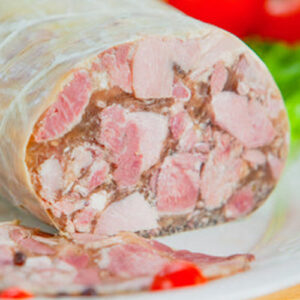Slices of the Past—The Cold Cuts That Filled Our Lunchboxes

Whether you called them cold cuts, luncheon meats, sandwich meats, lunch meats, or deli meats, they were a fixture in every brown-bag lunch when I was growing up. My father favored olive loaf and pimiento loaf—neither of which ever won me over.
My own tastes were simpler: American cheese on Mrs. Baird’s white bread, slathered with Miracle Whip (my family didn’t switch to mayonnaise until I was nearly grown), with crisp iceberg lettuce. Sometimes I’d have Vienna sausages. My mother was partial to bologna, and by my teens, I’d learned to enjoy it too.
These days, many of the cold cuts from my childhood have either become hard to find or disappeared altogether. Yet lunch meats still have a place in the American kitchen, their convenience fitting neatly into busy schedules. The market has simply evolved—now offering low-sodium, nitrate-free, organic, and even plant-based varieties.
Here’s a look back at six classics from the 1940s through the 1960s.
Olive Loaf
 Once common in grocery store deli cases, olive loaf is essentially bologna—typically a blend of beef and pork, sometimes turkey or chicken—with slices of pimiento-stuffed Manzanilla olives mixed in. It’s seasoned with coriander, mace, and black pepper, bound with potato starch and corn syrup, and preserved with sodium nitrite and sodium lactate.
Once common in grocery store deli cases, olive loaf is essentially bologna—typically a blend of beef and pork, sometimes turkey or chicken—with slices of pimiento-stuffed Manzanilla olives mixed in. It’s seasoned with coriander, mace, and black pepper, bound with potato starch and corn syrup, and preserved with sodium nitrite and sodium lactate.
While Boar’s Head and Oscar Mayer once made it, both have since discontinued it. Today, companies like Dietz & Watson, Eckrich, Kretschmar, Kowalski, and Koegel still produce olive loaf, but you may have to search by region to find it.
Bologna
 Whether you call it bologna or baloney, this cooked sausage was a lunchbox standby in mid-20th-century America, especially during the Great Depression. For many, it meant white bread, mayonnaise, and a slice or two neatly wrapped in wax paper—or a fried bologna sandwich, a Southern favorite.
Whether you call it bologna or baloney, this cooked sausage was a lunchbox standby in mid-20th-century America, especially during the Great Depression. For many, it meant white bread, mayonnaise, and a slice or two neatly wrapped in wax paper—or a fried bologna sandwich, a Southern favorite.
Traditionally made from pork, though sometimes turkey, chicken, beef, or a combination, bologna is seasoned with nutmeg, coriander, black pepper, allspice, celery seed, and myrtle berries. Federal regulations require it to be finely ground, like frankfurters and other cooked sausages.
Regional variations still exist: coarse German-style bologna in northern Ohio, finer “ring” bologna in the south of the state, and high-fat “chub” bologna in West Tennessee.
Head Cheese
 Despite the name, there’s no cheese involved. This old-world meat terrine is made from the meat of a calf or pig’s head—often including the tongue—set in aspic and served cold.
Despite the name, there’s no cheese involved. This old-world meat terrine is made from the meat of a calf or pig’s head—often including the tongue—set in aspic and served cold.
Variations span the globe: potted heid in Scotland, brawn in Britain and Australia, Sülze or Presskopf in Germany, Presswurst in Austria, pichti in Greece, and coppa di testa or formaggio di testa in Italy. The recipes differ, but the concept remains the same—flavorful, well-seasoned cuts suspended in a savory jelly.
Liverwurst
 Brought to the U.S. by German immigrants, liverwurst—also called liver sausage—has a long history in northern Europe. Made from pork and beef liver blended with meats like veal or pork shoulder, it’s flavored with black pepper, marjoram, allspice, thyme, nutmeg, and mustard seed.
Brought to the U.S. by German immigrants, liverwurst—also called liver sausage—has a long history in northern Europe. Made from pork and beef liver blended with meats like veal or pork shoulder, it’s flavored with black pepper, marjoram, allspice, thyme, nutmeg, and mustard seed.
Some varieties are smooth and spreadable, like pâté; others are firm enough to slice. Flavored versions may include onion, bacon, lingonberries, or mushrooms. While still found in American delis, liverwurst remains especially popular anywhere German heritage runs deep.
Vienna Sausage
 Though its name points to Austria, the American Vienna sausage is its own creation—shorter, canned, and softer than its European cousin. Made from finely ground pork, chicken, or turkey, it’s cooked in casings, then cut into bite-sized lengths and packed in brine, gelatin, or sometimes barbecue or chili sauce.
Though its name points to Austria, the American Vienna sausage is its own creation—shorter, canned, and softer than its European cousin. Made from finely ground pork, chicken, or turkey, it’s cooked in casings, then cut into bite-sized lengths and packed in brine, gelatin, or sometimes barbecue or chili sauce.
These little sausages became a pantry staple after World War II, lasting well into the 1970s. Today they’re less common, but for many, one whiff from the can is enough to bring back a flood of childhood memories.
Potted Meat
 Before refrigeration, potted meat was a way to keep cooked meat from spoiling—season it well, seal it under a layer of fat, and store it cool. Commercially, it evolved into a canned product made from seasoned, cooked, minced meats, shelf-stable for months or even years.
Before refrigeration, potted meat was a way to keep cooked meat from spoiling—season it well, seal it under a layer of fat, and store it cool. Commercially, it evolved into a canned product made from seasoned, cooked, minced meats, shelf-stable for months or even years.
Often eaten on crackers or in sandwiches, potted meat is salty, fatty, and not exactly health food. But its long shelf life has kept it useful for camping trips, emergency kits, and military rations—despite its polarizing texture and taste.
These six cold cuts were part of my family’s table for decades. Some are still around, others have faded into memory, but each one carries the taste of a time when a loaf of white bread, a jar of Miracle Whip, and a few slices of something from the deli could make lunch feel just right.
Bon appétit.






